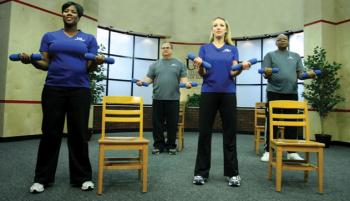Exercise
The benefits of regular exercise for people of all ages have been well established in the literature. Regular physical activity and exercise are associated with decreased risk of death and/or disability from pathologies such as cardiovascular disease, diabetes, arthritis, cancer and pulmonary disease. It is also associated with positive psycho - logical benefits such as decreased depression and improved quality of life. Nevertheless, inactivity continues to be a major public health concern with people not exercising as recommended. By dispelling misunderstandings and increasing understanding of the new recommendations for physical activity, individuals can once again find the time for exercise.
What Type of Exercise Do You Need?
The National Institute on Aging and the U.S. Department of Health and Human Services both recommend performing different types or kinds of exercise. Participation in all four types of exercise is needed for the full health benefit of physical activity. The types of exercise are balance, endurance or aerobics, strength training or weight lifting, and stretching or flexibility. The key to fitness is to do all four of the major types of exercise regularly and increase your level of intensity over time.

Balance exercises
Balance exercises help prevent falls, not an uncommon problem in older adults. Falling is a major cause of broken hips and other injuries that often lead to disability and loss of independence. Some balance exercises build up your leg muscles, while other exercises focus on your stability. Examples of balance exercises include several strength exercises for the lower body such as side leg raises and toe stands, as well as stability exercises such as heel-to-toe walking and the stork pose (standing on one foot with arms held out to the side).

Endurance exercises
Endurance exercises increase your breathing and heart rate. They improve the health
of your heart, lungs and circulatory system. Increased endurance keeps you healthier
and improves stamina for daily activities. Endurance exercises may also delay or even
prevent many diseases associated with aging, such as heart disease
and diabetes.
Examples of endurance exercises are walking, jogging, dancing and playing tennis.
Strength training makes you stronger by building muscle. This increased strength allows
you to perform daily activities on your own. Strength training also plays a key role
in keeping obesity and diabetes at bay by increasing your metabolism, which helps
you maintain a healthy weight and normal blood sugar levels. Additionally, studies
suggest strength training
may help prevent the progression of osteoporosis. Examples of strength training exercises
include lifting or pushing free weights, pulling resistance bands and using strength-training
equipment at a fitness center or gym.

Stretching exercise
Stretching exercises keep your body flexible by stretching the muscles and tissues
that hold your bones together. While exercising, rate your perception of your total
feeling of exertion, combining all sensations and feelings of physical stress. Looking
at the rating scale below while you are engaging in an activity, choose the number
that best
describes your level of exertion.

Strength exercise
Strength training makes you stronger by building muscle. This increased strength allows
you to perform daily activities on your own. Strength training also plays a key role
in keeping obesity and diabetes at bay by increasing
your metabolism, which helps you maintain a healthy weight and normal blood sugar
levels. Additionally, studies suggest strength training may help prevent the progression
of osteoporosis. Examples of strength training exercises
include lifting or pushing free weights, pulling resistance bands and using strength-training
equipment at a fitness center or gym.